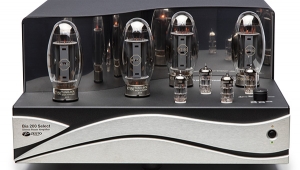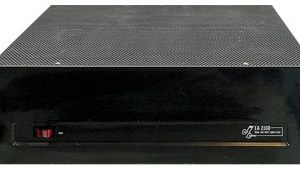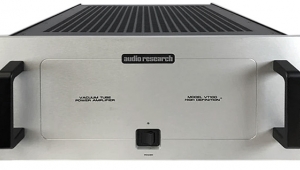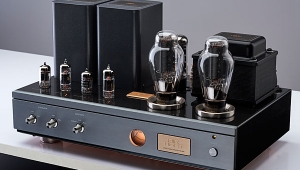| Columns Retired Columns & Blogs |
Sonic Frontiers Power 3 monoblock power amplifier Kalman Rubinson July 2000
Kalman Rubinson wrote about the Power 3 in July 2000 (Vol.23 No.7):
I'm going to cheat a little here. My comments on the Sonic Frontiers Power 3 monoblock power amplifier are a Follow-Up to Brian Damkroger's review in the April 2000 issue...my feelings differ significantly from Brian's.
The Power 2 power amplifier sat in my listening room for more than a year. Over that time, and however much I resisted the prospect, I ended up choosing it—over every other amp and with almost every speaker—for enjoying music. Sure, the Bryston 7B-STs had more slam and punch, the Simaudio Moon W-5 was more powerful and just as smooth, and the McCormack DNA-1 had more sparkle and life. But I hooked up the Power 2 whenever I just wanted to listen to music. By common practice, it became my reference. It's not perfect, but the softness of the bass and its tendency to seem a bit mellow were acceptable in the context of its overall integrity of sound.
So even before I had a chance to read BD's review of the Sonic Frontiers Power 3 monoblock amplifiers, I arranged to buy the review pair. Surely, the Power 3 would retain all of the characteristics of the Power 2 that I so prized, and the scaled-up monoblocks just might correct the 2's lapses. The Power 3s were still on their circuitous trip from BD to TJN (for testing) to Sonic Frontiers (for a checkup and retubing) to me, when I saw BD's review in print and read, with horror, that "These amps don't rock." Had I just blown it?
I need not go through all the details of the Power 3, because I can find nothing to dispute in Brian's observations: I heard the same things. Moreover, I think he and I would agree that we don't want a component that sounds "good" or "great," but one that doesn't "sound" at all. Still, one needs only to glance at the comments that Brian and I have made over the years about Sonic Frontiers components (encapsulated in the "Recommended Components" listings for the Line 2 and Power 2 in the April Stereophile) to predict that we would not have the same emotional response to the Power 3. In addition to our having different heads and hearts, our system contexts (sources, speakers, rooms) are quite different, and our musical interests only partly overlap. Finally, I don't share Brian's expressed tolerance for small "errors to the warm, liquid side," and I am more likely to forgive small subtractive ones that do not exacerbate the resonances that can pop up throughout the audio chain and pique me. I like things tight and clean.
The system into which I inserted the Power 3 included the already resident $4999 Line 3 preamplifier and the Revel Ultima Studio loudspeakers. The most immediate improvement of the Power 3 over the 2 was in the extension and solidity of the bass, where the Studios offer ample opportunity for demonstration. Although the 2 was warm and ever so slightly soft at the bottom, the monoblock 3s had steel fists in their velvet gloves, and dealt handily with the demands of Mahler, Widor, and Pink Floyd. No warmth? No, but satisfying full and dramatic.
At the other end of the spectrum, in John Culshaw's pellucid and powerful production of Strauss's Salome with Nilsson, Solti, and the Vienna Philharmonic (London OSA 1218), not only were Salome's veils dropped; so, too, was any ambiguity of detail in the upper strings and percussion. The tonal quality of the midrange through the Power 2 and Power 3 may be quite similar, but the Line 3 preamplifiers' clarity and image depth were distinct advances on the Line 2's. In other words, the combination of Power 3 and Line 3 was even more neutral than that of the Power 2 and Line 2: the former emulated the grinning Cheshire Cat even more exactly as they continued to disappear.
I do acknowledge Brian's observations on the Power 3: There was some dryness throughout the midrange with the OLS Kharma Ceramique 2 speakers and compared to the McCormack Rev-A DNA-1. With the Revel Ultima Studios (and helped by some recently added acoustic room treatment), there seemed to be nothing missing. The sound was neither rich nor dry, but balanced. I did not feel that the Power 3/Line 3 combo sapped the life from the music, but rather that it offered the music stripped of added embellishment. Soundstage depth and width were beyond cavil, as was instrument localization, but these parameters are much more greatly influenced by the speaker/room setup than by the electronics.
Dynamics: I knew I'd have to deal with this. Like most of us, I have two listening modes, and what I hear is often determined by which mode I'm in. With my audiophile (and reviewer) hat on, I listen for the sounds in the music. With my music-lover hat on, I listen to the sounds of the music. In audiophile mode, I heard everything that Brian, almost apologetically, describes as limitations in the Power 3's presentation of micro- and macrodynamics and how this affects other issues. Yet I have to force myself to listen for them, and would perhaps not have noted them without his suggestion.
But even when I do, I am impressed by how often the Line 3/Power 3 combination simply ravishes me. From the revelation of Dietrich Fischer-Dieskau's subtly modulated vocal inflections (Cerha's Baal Gesänge, Berlin Classics BC 2072.2) and the interplay of intimate voices in a Janácek string quartet (Bayer 10051) to the inexorable impact of Mahler's Symphony 6 (Bernstein, DG 427 967-2), the Line 3/Power 3 kept blowing my audiophile hat right off! My impression—directly opposed to Brian's—was of a very extended dynamic range. I thought the sound quite accurate in terms of dynamics, neither compressing nor emphasizing gradations, and that some contrasts were, appropriately, just not as big as others.
In matters of the audiophile heart, everything's subjective. If Brian were to visit, he'd probably think that my system sounds damn good; I'm sure I'd have the same response to his. More than likely, we'd both be much happier in our own homes with our own music. It's not necessarily bad or surprising news that no single component can please everyone. The good news is that for me, Sonic Frontiers' Power 3 and Line 3 were completely satisfying. They just got out of the way and let me at my music. In fact, I have bought both of SF's top-of-the-line offerings for my reference system.—Kalman Rubinson
- Log in or register to post comments



































